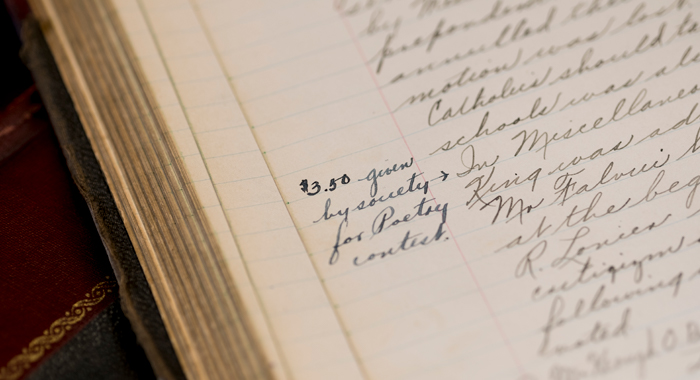Treasure Hunt
Sally Cubitt (Library) has been a valued behind-the-scenes facilitator for our regular “Treasure” feature. To mark her recent retirement from her post as coordinator of collection management, we invited Cubitt to unearth five of her own favorite “treasures” from the college archives.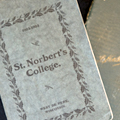 The Earliest College Catalogs
The Earliest College Catalogs
The college’s yearbooks didn’t begin publishing until 1917, so the early catalogs served as both college catalog and yearbook. They list courses of instruction, classes and information about the college, but they also list the groups on campus, the band, athletics information, Commencement activities … . The graphics in the 1908-09 catalog are really pretty and there’s a lot of interesting information in here. As well as admission information, the catalogs also list what you needed to bring with you to college. You had to bring a napkin ring, but the college supplied the napkins. How the times have changed! And then there is tuition information in there, too… $225 for a full 10 months’ board and tuition!! Only $6 a month for meals! They’re just really interesting to look at. The college started issuing catalogs for the 1903-04 academic year, and we have all of them through to the present day.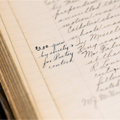 The Minutes of the St. Augustine Literary & Dramatic Society
The Minutes of the St. Augustine Literary & Dramatic Society
This is latest thing I’ve discovered that I think is really cool. These are the minutes from meetings of the St. Augustine Literary & Dramatic Society, which formed in 1901 and was our first student organization. It was formed to prepare students for public speaking and to give them opportunities in dramatics and elocution. Their programs actually made the De Pere newspaper – even their minutes were published in the news. For example, at their fifth meeting, they had a Mr. John Dewitt give an introductory talk on Lewinian Theory – in Dutch. Then, there was supposed to be a debate on the resolution that “Printing Has Done More Harm Than Good,” but “… owing to the carelessness of the members who were to uphold the negative, the debate was not held.” This group even started their own library! There is a will in the first page of the first volume (“The Last Testament of the Society”), granting that the library will go back to the Norbertine fathers. It’s signed by our founder, Father Bernard Pennings; by Father Hurkmans, Father Smits and others. Everything was properly documented according to the format taught in the commercial course offered at the college at the time. (When the college first started, it was intended to offer training for the priesthood, but then they realized the need for a Catholic college that would prepare people for business, too, so they offered the commercial course where they taught shorthand, typing and business procedures.) The Incunabulum
The Incunabulum
The printing press was developed in 1450 and, over the next 50 years, publishers would learn how to print with movable metal type. The books that were printed at that time – there are about 30,000 still in existence – are called incunabula. We actually have one here, the Complete Works of St. Augustine, published in 1491. It’s in amazing shape. Our incunabulum is not complete because it is missing the illumination, or the ornate initial letters that should have opened each section. You can see where the printers marked which letters were intended for those spots. They still followed other practices from hand-written manuscripts, using abbreviations and conventions such as replacing the “ands” with little symbols. They also did lots of editing to shorten certain words and phrases until they realized they didn’t have to do that anymore. Once you set the type, it’s there for all subsequent editions and you can print as much as you want. My favorite thing about this book is, someone has annotated it but, to mark the important things, they didn’t use arrows, they used little hands with a pointy finger called manicules. Some have arms, too! I don’t know if they just got carried away, or if that note was even more important. 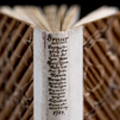 The Witch Trial Book
The Witch Trial Book
This one makes the list because it was I who found it listed in an antiquarian bookseller’s catalog and was able to purchase it for the college. Every once in a while, something pops up that relates to our collection here and is affordable, and adds to the history of the college and the Norbertines. This is a beautiful little book with a terrible story. In 1749, at a Norbertine convent in Bavaria, lived a sub-prioress named Maria Renata Saenger Von Mossau. She was 65 years old when she was accused of witchcraft. She confessed under duress, and they tried her and found her guilty, and sentenced her to death. Because of her status as a religious, they allowed her the privilege of beheading her first, before they burned her at the stake. Maria Renata was one of the last women in Europe to be executed for witchcraft. This book contains a handwritten account, in German, of her trial and execution. It was written in 1754 by an unidentified scholar. 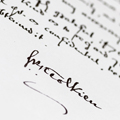 The Tolkien Letter
The Tolkien Letter
This is a letter from J. R. R. Tolkien to Bob Boyer (English, Emeritus), and donated to the archives by Dr. Boyer. It’s one of my favorite things in our archives. Beyond its historical significance, the amazing thing about it is, that is how I imagine Tolkien would write. The handwriting – it almost looks like Elvish! We have very few documents in the archives like this, so it makes it even more special. Dr. Boyer did his dissertation on W. H. Auden, and he corresponded with Tolkien seeking information about the poet: Auden and Tolkien were close friends at Oxford University. (In fact, it was hearing Tolkien’s beautiful recitation of “Beowulf” that first won over the young Auden to the study of Anglo-Saxon.) This letter came to the archives as part of Dr. Boyer’s scholarly collection, a gift to the college in August 2012.
March 17, 2017





